Mutley's Hangar
A Haven For Flight Simulation Enthusiasts!
.jpg)
For FSX / Prepar3D Published by Aerosoft
Reviewed by John Guest
September 2014
Introduction
Aerosoft's English Electric 'Lightning' F.3 caught my attention as
soon as it first appeared on Aerosoft's website. It just so happens
that the English Electric 'Lightning' happens to be one of my
favourite aircraft. For me, it represents the pinnacle of aircraft
development in the history of British aviation. This Aerosoft title
is one I could not resist, so after a brief look at the real thing,
let’s take a look at what you get for your money.
Background
English Electric are famous for building another aircraft, the
English Electric 'Canberra'. This was a truly remarkable aircraft,
capable of flying at 50,000 ft., and with a nuclear capability. In
an exercise just after the 'Canberra' came into service, it became
clear that the RAF was unable it intercept such an aircraft, and so
Requirement Specification ER.103 emerged to produce an aircraft that
could. This aircraft was also to be capable of traveling up to Mach
1.5. The design submitted in response to this requirement was that
of the English Electric P.1A. It was to be able to meet or exceed
all the requirements of the specification and do this with an
amazing initial climb rate of 50,000 ft. per minute, something no
other aircraft could rival.
Two P.1A prototypes were built, the second improvement on the first,
and was distinguishable by having the underbelly fuel tank bulge
that was seen on the production aircraft. Both P.1As had a teardrop
air intake at the front with no cone.

English Electric P.1A
The P.1B was an improved version of the P.1A and looked like the production aircraft, having the coned intake and the underbelly fuel tank bulge. The P.1B is distinguishable by the tail, which has a filet, this was absent in the production aircraft. The P.1B was a success, exceeding Specification ER.103, and was chosen to go into production.
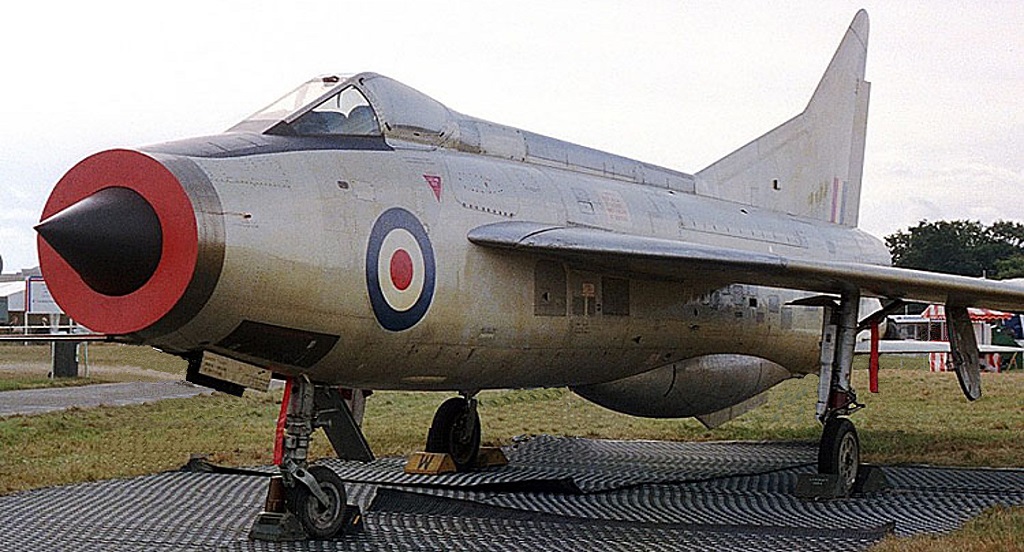
English Electric P.1B
Production started on the F.1 and the F.1’s armament included two Aden cannons, and air to air rockets or missiles. The cannons were mounted in the nose, each side of the pilot and above the air intake. The F.2 was virtually the same aircraft but with some minor modifications. These two versions were limited to Mach 1.7 because of airframe strength concerns.
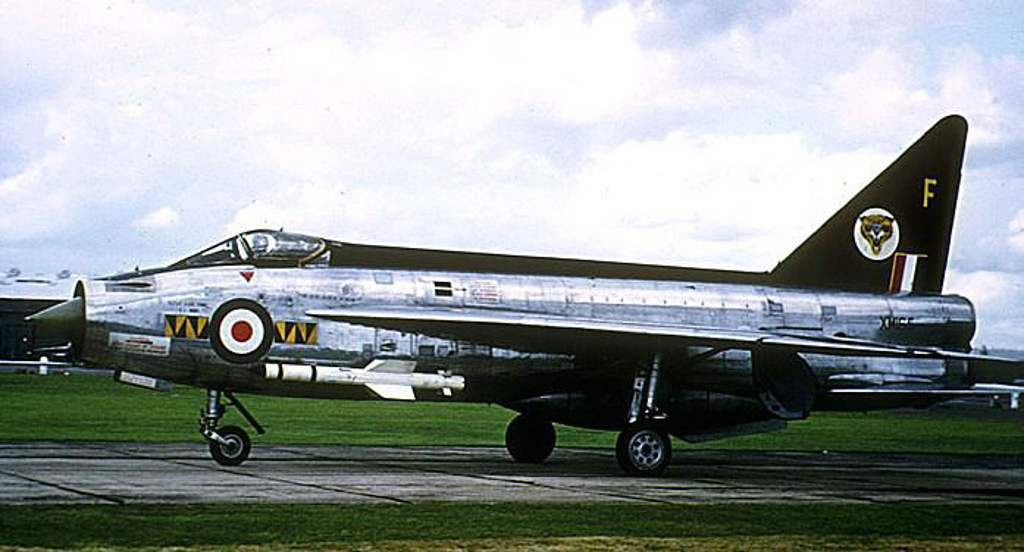
'Lightning' F.1 - Cannon Ports Visible on the Upper Nose
The F.3 was a major development on the F.2. The cannons were removed and replaced with forward looking radar, the wing leading edges were improved, it had a greater fuel capacity, the fuselage was strengthened, more powerful engines were fitted, and the tail was flattened at the top. This version could exceed Mach 2.
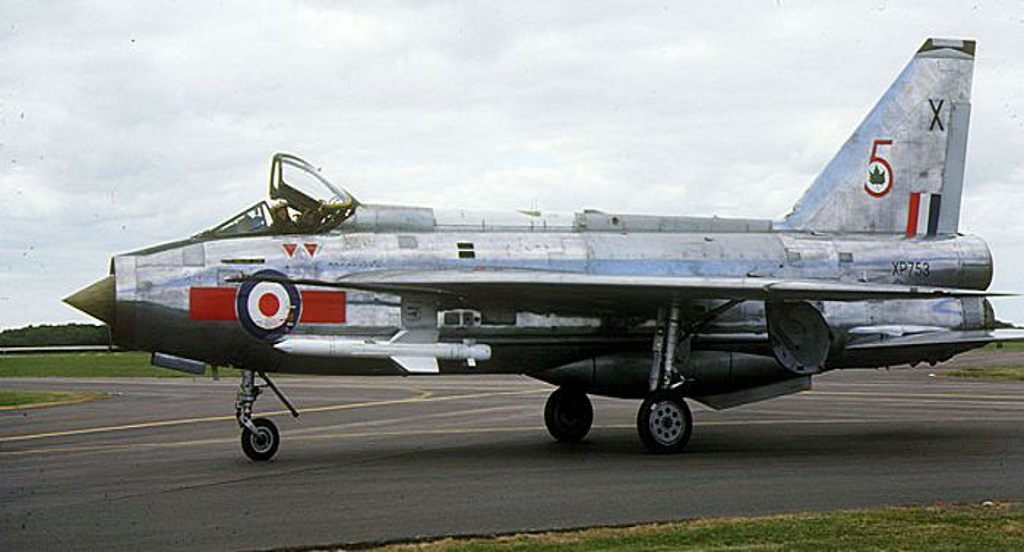
'Lightning' F.3
The F.3 was eventually replaced by the F.6 with increased fuel capacity, noticeable by its much larger ventricle bulge which contained both fuel and reintroduced cannons. Fuel capacity was doubled by providing over wing, ferry fuel tanks which could be jettisoned.
It is important to note this aircraft was not designed as a fighter. Its primary role was that of an interceptor. Its job was to get to a height as rapidly as it could and destroy an incoming enemy aircraft armed with a nuclear bomb. Don’t forget, the aircraft was designed before the days of nuclear missiles. Its flight plan would be rapid climb to 60,000 feet, intercept and destroy an incoming enemy aircraft, return to base and be ready to do the same again as soon as possible. Consequently, its low fuel capacity was not seen to be an issue as the expected flight time was to be measured in minutes rather than hours.
Pilots who flew the 'Lightning' loved it. It was, by all accounts, a delightful aircraft to fly. I have to admit, for me, that is part of the mystery and wonder of this aircraft. You only have to see a 'Lightning' take off to understand this was no ordinary aircraft. Whilst a delight to, it was no walk in the park to either, and the pilot had little in the way of sophisticated equipment to help him. There were no complex fly by wire systems, no computer aided decisions for the pilot to make, no frills, nothing of that ilk whatsoever. It was, after all, conceived just a few years after the World War II.
What you did have were two massively powerful engines stacked one on top of the other and a stick to control it with. So I have to ask the question, was it a delight to fly in the same way as a Spitfire, graceful, responsive and a sublime experience? Or was it a delight to fly because it scared you so much that you had to change your trousers every time you few it? I will never really know, as no self-respecting pilot would admit it, but I suspect it was the latter. Let’s see if Aerosoft’s version provides any clues.
Aircraft Specifications
The specifications of the English Electric 'Lightning' F.3 are as follows:
● take-off speed - 160 kts at 30,000 lbs;
● maximum take-off weight - 35,500 lbs;
● maximum normal landing weight - 34,500 lbs;
● maximum speed - Mach 2.27 at 36,000 ft;
● minimum speed clean - 180 kts;
● minimum speed clean, flaps and undercarriage down - 140 kts;
● initial rate of climb - 50,000 ft/min;
● landing speed - 155 kts;
● engines: 2 x Avon 301R;
● ceiling: 60,000 ft + (FLTLT Mike Hale recorded 88,000 ft in 1984);
● crew: one;
● radar: AI-23B; and
● armament: 2 x Red Top missiles.
Availability and Installation
This aircraft add-on is available from the Aerosoft web site as a 'download only' product. It is priced at €24.95 (including VAT), or the equivalent on currency cross rates. The file size of 250MB is reasonable for an aircraft of this type and quality and it requires 610MB of HDD space for installation. Installation is simple and is managed by an executable file which automates the process. The package supports Microsoft Flight Simulator X with Acceleration and Perpar3D v2.2 or higher. This review is based on the FSX version.
Documentation
The product comes with three documents. Volume 1 is the add-on’s manual, which is available as a free download from the Aerosoft website. The other two are scanned copies of documentation on the real aircraft. Volume 2 is a guide to the cockpit and Volume 3 is a scanned copy of the original pilot’s notes. These scanned booklets are a testament to the quality of the add-on. The document which is a scanned copy of the original aircraft’s cockpit guide can actually be used to find your way around the add-on's cockpit. Another of the documents included is the original pilot’s notes. These are more of an interesting read but some of the information contained in this documentation is relevant to the add-on, especially the information on the aircraft’s procedures, limitations and instrumentation. Included in this scan is another cockpit layout guide.
Finally there is the add-on’s own manual. This is an 18 page manual which covers all the information you need to know to get started with the aircraft. There is a brief introduction which traces the fate of the aircraft presented in the simulation. There are the usual sections on the system requirements, installation, support, recommended FSX settings keyboard assignments etc. I felt that there could have been a bit more information available in this document in just a few areas. For example: there is a section on inflight refuelling, It tells you that is possible, and a height band in which you can do it but no more that this. Not a clue on how to initiate the refuel. Nice though the original documents were, and all credit to the accuracy of the virtual cockpit, but I felt that a corner had been cut here and the scans used to make up the difference. In any event the document set did not meld together well.
On the other hand, there was a detailed set of cockpit panels with instructions of how each usable button worked. By that I mean buttons to drag, those that have both left and right mouse click functions etc.. A nice and very useful touch I thought. Detailed information on what the buttons do is available in the real aircraft cockpit document. Other more complex items such as the radar scope were explained in greater detail here.
External Model
Having read up on the 'Lightning', I was expecting raw power and great beauty. Starting FSX with the F.3 cold and dark, the first thing I did was a walk around - a full body inspection. It’s worth mentioning here that the title 'Lightning F.3' is a bit of a misnomer. Sure there is an F.3, and it comes in several colour schemes, but there is also a single example of the F.1A and the F.2. As you will see from the illustrations below, from the exterior at least, these two bonus variants match their real world counterparts. Unfortunately, that is as far as it goes. The performance and virtual cockpit for these two extra aircraft are identical to the F.3. One can’t help feeling that a speed limitation of Mach 1.7 for these earlier variants would have been nice to reflect the top speed of the real world counterparts.
My walk around started at the nose. With the F.3 under scrutiny, what met my eyes was very pleasing indeed.

Looking at the Engines Behind the Cone
Looking into the air intake behind the cone, a single engine can be seen. This is the lower of the two engines. So far so good. It is right that only one engine can be seen as the second engine is mounted above and behind the first. It would not be visible without the aid of a torch. The cone mountings are good, as are the colours used. Next I duck under the wing to check out the undercarriage. The detail in the undercarriage legs, wing void and doors is very good indeed. All good so far.

Undercarriage and Bay
Emerging at the tail, I glance at the tail fin. It’s an F.3 for sure, as the tail is cropped as it should be.

F.3 Tail - Clipped at the Top
I then switch to the F.1A to make sure that this detail has been changed to conform to the F.1A's true life form.

F.1A Tail - Pointed at the Top
It has a rounded tip, still all good then. Next, the engines from the rear perspective. As anticipated, there are two engines mounted one on top of the other. Well rendered turbines are visible as they should be. The fuel delivery rings for the afterburners are clearly visible.

Jet Exhausts with Afterburners
After checking the other side of the aircraft, I come to the nose again.

F.3 Nose - No Guns
The F.3 nose has no guns visible and the 'Red Top' missiles have nicely rendered lensed noses. With the F.3, the 'Red Top' missiles are default, but can be exchanged for 'Firestreak' if wanted.
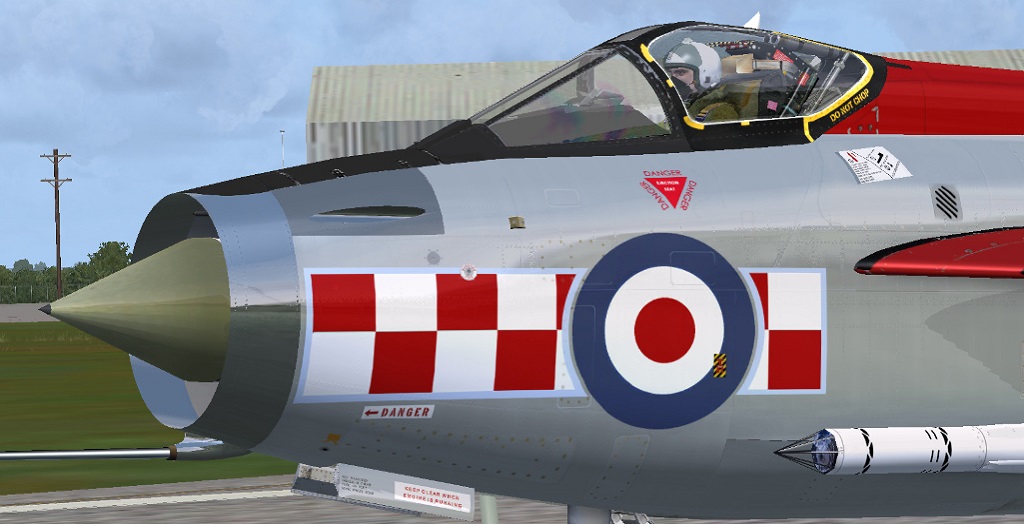
F.1A Nose - Gun Ports Visible
The F.1A’s nose has the gun ports visible, normally shrouded, but open as shown in the screen shot when 'guns' are selected on the weapons control in the cockpit. Nicely rendered 'Firestreak' missiles are present on the F.1A and F.2 and are not interchangeable with 'Red Top' missiles as these variants of the 'Lightning' did not carry them.
Over all, the detail and rendering is superb, as the screen shots so far have illustrated, with beautiful burnished metal and incredibly clear markings etc..
Aircraft Interior
This add-on is a high end product. As with most top of the range aircraft, there is no 2D cockpit. I feel this does not detract from the product at all. This is a complex aircraft simulation and a 2D cockpit would not be able to cope with half of what is on offer here, and like many recent high quality products, a 2D cockpit would be worthless baggage. If you like to fly 2D, then this product is not for you - go and buy something simple.
For all the aircraft in this package, the virtual cockpit is that of the F.3. OK, so this is not quite right, the F.1A and F.2 cockpits were different, but I think it is acceptable, given the complexity of the virtual cockpit. For those of you who are wondering what the earlier variant 'Lightning' cockpit was like, the answer is, quite different. No thermometer style airspeed indicator in the F.1A and F.2 and the large radar scope wasn’t in the F.1A.

The Real Cockpit
The cockpit contains so many usable switches it is difficult to know where to start. I cannot begin to list everything that can be done from the virtual cockpit, it’s just too much. Suffice to say, everything that FSX allows and is pertinent to the 'Lightning' F.3 can be done from the virtual cockpit, and a bit more besides.
One particular favourite feature of the virtual cockpit and of the real aircraft is the thermometer style airspeed indicator. This moves a marker up the scale from left to right until it reaches about 600 kts at the extreme right hand side of the gauge. As Mach numbers takeover, a scale then moves from right to left under the stationary marker to indicate the airspeed by Mach number.
Back in the 1970s I owned a Morris 1100. It too had a thermometer speedometer. I can’t help wondering if this car's speedo was inspired by the gauge in the 'Lightning'. If so, I can’t think of a more un-appropriate car to have such a thing!
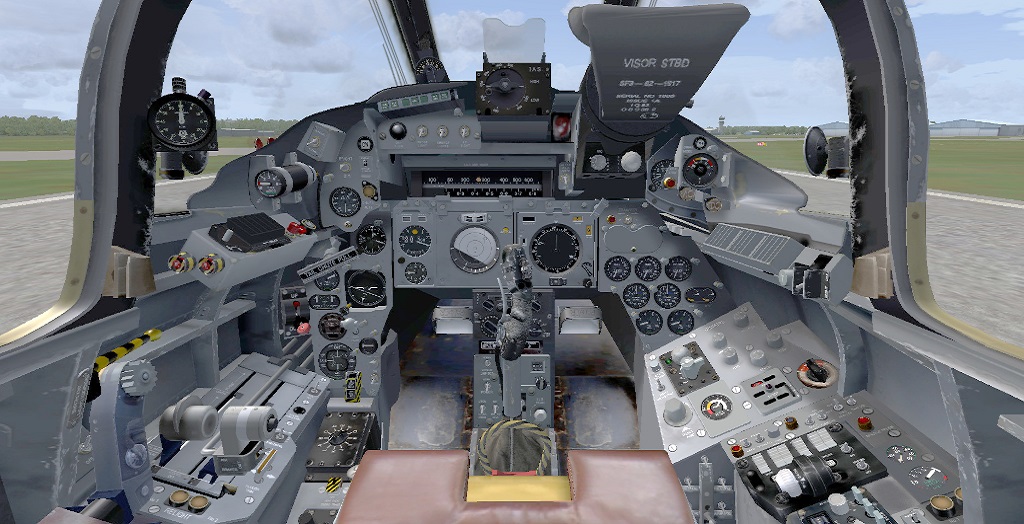
The Aerosoft Cockpit
One of the more prominent features of the cockpit on the 'Lightning' is the radar scope. In the illustration above it is stowed away with its cover on, as it would be when not in use.

Using the Radar with the Sun Shield
The cover can be opened such that it forms a sunshield to enable the pilot to see the radar screen in bright sunlight. Alternatively, the cover can be removed and stowed away for night use of the radar. This can be seen in the illustration below.

Using the Radar Without the Sun Shield
The radar function is not true to the real life counterpart, this would be impractical to implement in FSX or P3D. Instead, the radar offers several 'Modes' which can be selected by a dial which provide what appears to be a customised version of the GPS output available in many FSX/P3D aircraft. The only problem this radar has is its visibility. With the sun shade on it is necessary to move the pilot’s vision to the right by a fair amount, this is not achievable by head movement alone. The pilot has to physically move to the right whilst still looking forward. Not much of a problem if you have a device like 'TrackIR', but harder when using keyboard alone. The only way to achieve this required view is to use the eye point left/right commands which can be a bit fiddly. It’s probably better to remove the cover completely.
Model
There are separate models for the F.1A, F.2, and the F.3. However, differences in the models seem to be limited to outward appearance only. I can’t help thinking this is a shame. Why go to all the bother of creating an external F.1A and F.2 appearance and not make the changes to make them perform differently. As I said before, having the single virtual cockpit is, in my opinion, understandable, but to at least tweak the top speeds down a bit to give the feel of the earlier variants was an opportunity missed.
It does state in the manual the F.1A and F.2 outward appearances are there for repainting purposes only, but as far as I can see, there is no paint kit available. Another opportunity missed.
Liveries
The Aerosoft 'Lightning' comes with nine liveries, seven F.3 liveries, one F.2 livery, and an F.1A livery. These cover liveries from the early 1960s to the early 1980s, and therefore cover the whole period that 'Lightnings' were in service. The liveries are shown below.

Above Left to Right
'Lightning' F.3, 11 Squadron, RAF, 1983
'Lightning' F.3, 56 Squadron, RAF, 1967
'Lightning' F.1A, Firebirds Aerobatics Team, RAF, 1963

Above Left to Right
'Lightning' F.3, 29 Squadron, RAF, 1967
'Lightning' F.3, 74 Squadron, RAF, 1965
'Lightning' F.3, 'Lightning' Training Flight, RAF, 1975
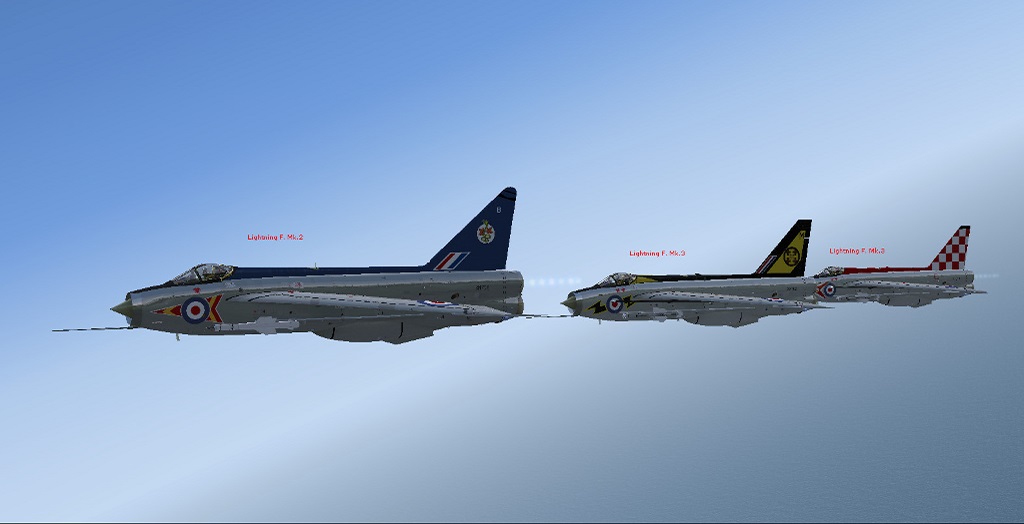
Above Left to Right
'Lightning' F.2, 92 Squadron, RAF, 1963
'Lightning' F.3, 111 Squadron, RAF, 1964
'Lightning' F.3, 56 Squadron, RAF, 1967
'Lightning' in Flight
Before we start, let’s quickly look at the options you have to configure and start the aircraft. Pressing 'Shift + 2' brings up the screen below.
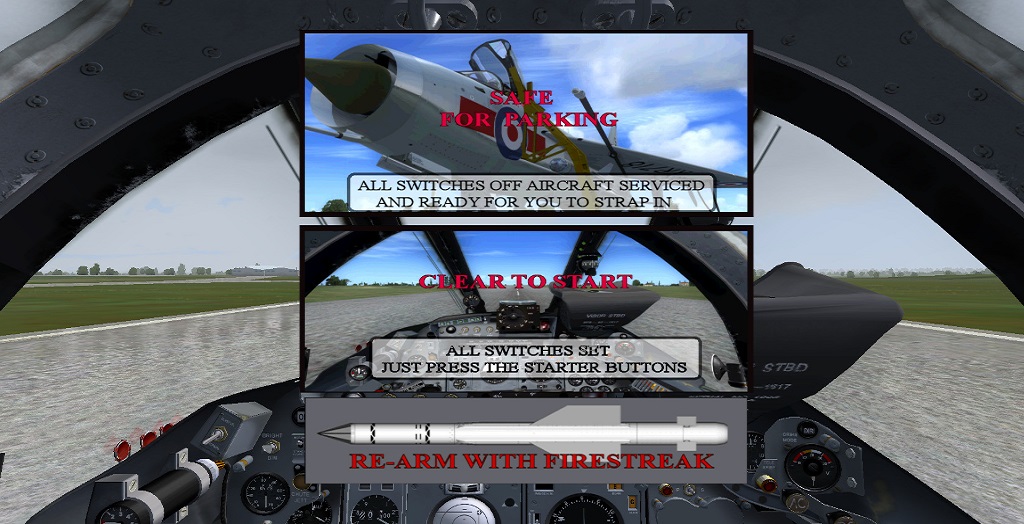
Configuration Screen
This screen allows you to choose a 'cold start' or a 'hot start'. For the F.3 variants, it also allows you to swap out the 'Red Top' missiles for the older 'Firestreak' armament.
Walk around completed, it’s time to put the F.3 to the test. To do this I am going to fly three sorties out of Farnborough. Flight one will be a scramble intercept mission, an all out after burner climb to 40,000 ft, a quick flight at altitude, and a rapid return to base. This emulates a classic 'Lightning' intercept. The second flight will be a more sedate affair, a fuel conserving take-off without afterburners and a ferry flight to Boscombe Down. The third, an attempt to find the ceiling of this aircraft. As mentioned above, FLTLT Mike Hale recorded 88,000 ft in 1984.
Flight 1 - The Classic Intercept
The 'Lightning' could be started one of two ways. The slow and steady check list way, or the rapid scramble way. The latter needs just three actions, switch on the oxygen, the master Gyro, and pull up the starter panel gang switch and you are good to go. Sitting on the end of the runway with the breaks on, push up the throttles, then let her go. As soon as she is rolling straight, it’s full afterburner on and a few seconds later you are airborne. Staying straight and level, retract the undercarriage, the nose wheel is last up, that’s realistic, and clean up the flaps. By now you are really moving, so its stick back to a 60 degree climb and the altimeter goes crazy.

Awesome Climb
A 60 degree climb is easily sustainable for the first 10,000 ft. After that the sustainable climb angle slowly decreases until at 30,000 ft where the climb angle is 20 degrees. Beyond this, the climb angle slowly deteriorates to five degrees at 50,000 ft. Anything above this is a much slower effort. On this, my first flight of the two, I had used almost 30% of my total fuel by 40,000 ft. Fuel was limited and probably gave me 15 to 20 minutes at normal power to make my intercept and return to base. Not a lot of time then. So that seemed to match the real thing fairly well. I have to say that flying like this is exciting stuff, there are few flight simulator add-ons which will get you to 40,000 ft as fast as this one will and few that will fly as high as this as well. Not having much time left, I did no more tests and returned to Farnborough. Landing is fast. The air breaks help to slow the aircraft down before and after touchdown and these are located each side of the fuselage, just where the tail fin starts. Once on the ground, cut the throttle and deploy the chute and the aircraft slows to taxi speed. Dump the chute and taxi to the parking area. My feelings after this first flight are that the flight dynamics and the aircraft’s characteristics are excellent.
Flight 2 - Ferry to Boscombe Down
The purpose of this flight is to fly as economically as possible in order to fly as far as possible between refuels. I will be looking at the fuel very carefully on this run. So, no afterburner, maximum flaps for take-off, and a more sedate climb to start with. Farnborough to Boscombe Down is only about fifty miles, so a cruise altitude of 15,000 ft was selected. This may not seem to be the best test for economy, but the 'Lightning' had a limited range, and so would not fly too far without an airborne refuel. The 'Lightning' uses a lot of fuel during take-off and climb so 15,000 ft was selected to minimise the fuel consumption that a significant climb would have for such a short hop. Both Boscombe Down and Farnborough were used for aircraft experimentation and development in the 1960s, and therefore, such a short flight between the two would be a realistic journey.
Flaps down and throttle forward to full power without afterburners, I was slightly alarmed at the length of runway needed to leave the ground. However, once in the air and with the flaps and undercarriage up, I set her up into a 15 degree climb. Such is the power of the 'Lightning' that FL150 was soon reached, but with a fuel cost of only about 10%. A short sub-sonic cruise was quickly followed be a decent into Boscombe. Landing the 'Lightning' at a shade under 200 kts is a fast and unforgiving experience. Like all early jets, the engines don’t respond immediately to an increase in throttle. There is a very pronounced lag from throttle to the power response. Slow too much on your approach and stall, and you are toast. You will not get the aircraft to respond in time. Approach speeds must be carefully monitored and a go around decision made earlier than most aircraft. Once a commitment to land is made, the air breaks may be used to slow the aircraft, but you are going to hit that runway going fast. This flight ended with 64% of fuel remaining, most of the consumption was incurred on take-off, and a fair amount whilst landing. From this performance, I would say the endurance fairly represents that of the real thing.
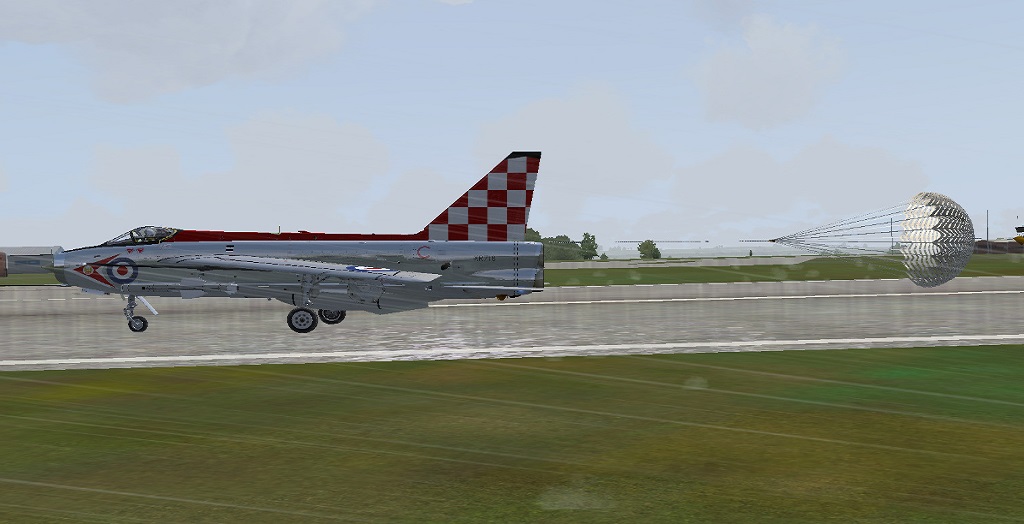
'Lightning' Landing
Flight 3 - Altitude Record Attempt
In order to gain such a dizzy height, the 'Lightning' had to climb to altitude conserving fuel as much as possible. But once at that altitude, the aircraft was accelerated to its maximum speed with full afterburner power, and then using this momentum, zoom up to the required height. Although the flight models are the same for all the variants in this add-on, I have chosen to fly an F.3 with a top speed of Mach 2.1 rather than the F.1A or F.2 which should be limited to Mach 1.7 for greater realism.
Take-off at normal power was uneventful, as was the climb, and at 40,000 ft I was doing about 350 kts and had used 20% of my fuel. That’s 10% less than the intercept climb, which is a significant amount in the 'Lightning'. Accelerating to Mach 2 at this height was sure and steady, with no handling issues, and at Mach 2 I pulled the stick back. The altitude went crazy as I shot upwards. 50,000 ft was passed very quickly, the climb slowing down after that, but I still continued rocketing upward. 60,000 ft was passed, but not so quickly this time. 65,000 ft passed with a significant slow down, and by 70,000 ft, climbing was becoming hard as I had lost a lot of airspeed. At 71,000 ft I topped out, with 60% of my fuel gone, I need to descend to get back to the airfield with enough fuel to land. Wouldn’t you just love to call up ATC and give your height as FL710!

71,000 Feet!
I felt that with a refuel at 36,000 ft, I could have gone higher, either by repeating the zoom climb or by slow degree. The performance in this exercise is what I expected when compared with real world accounts from 'Lightning' pilots.

The Edge of Space - You can see the stars in daylight and the curvature of the earth
All in all, the folks who put this package together have done a fine job. The flight characteristics and dynamics are all you would expect of this aircraft. It’s a beast, best at sprinting, and although very stable within its flight envelope, step to close to the edge and she will punish you - hard!
Special Effects and Extras
VC10 Tanker. A VC10 tanker is supplied as AI for simulated refuelling, as the range of the 'Lightning' is so limited. How you control the AI tanker is up to you although it is possible to refuel this add-on in mid-air without another aircraft. To do this, the aircraft must be between 10,000 ft and 36,000 ft and be flying at between 250 and 300 kts.
Sound Barrier Shock Wave and Sonic Boom. An additional animation is supplied with this add-on. As the aircraft approaches the sound barrier, a vapour cone builds up around the aircraft and dissipates after the sound barrier is breached. As this happens, a sonic boom can be heard. I haven’t come across this in an add-on before, and it is a nice little addition. It is only visible and audible from outside the cockpit so you have to be quick with the view change to catch it. As far as I could see, this only happens when you go through the sound barrier for the first time in a flight, which is a bit of a shame as it a fun addition and would be nice to repeat several times a flight.

Going Supersonic
Weapons. The aircraft is armed with an array of weapons:
● Missiles. The aircraft can be armed with a selection of missiles. Different aircraft variants have different default missiles. The F.3 is armed with
'Red Top' missiles, but these can be changed for the older 'Firestreak' missiles if required. The F.1A and F.2 have 'Firestreak' and they cannot
be changed. Firing the missiles requires an arming sequence, after which the joystick trigger is used to fire them. There are no animations for
the missile launch which is disappointing.
● Guns. The F.1A and F.2 have cannons in the nose. The F.3 was not armed with cannons. Selecting guns will uncover the gun ports in the nose
when flying the earlier variants, but I could not get the guns to fire. The F.3 has an identical arming knob which includes a superfluous
‘guns’ setting.
Checklists. The checklists supplied with this add-on are first class. There are two sets of checklists, a normal procedures checklist set which is accessible by using 'Shift + 3' on the keyboard and then selecting the tab on the list for the checklist you require. The thing that raises this aspect of the 'Lightning' above other add-ons is the inclusion of a full set of emergency procedure checklists. This is accessible by selecting 'Shift + 4' on the keyboard. Both checklist booklets are illustrated below.

Checklists
Sounds
A full set of sounds come with this add-on. They are of a high standard and the quality suggests they were recorded from the real aircraft. This is something that is expected for a high end add-on these days. The only thing I found strange was the lack of loud jet noise in the cockpit. Maybe that is realistic. After all, the business end is well behind you in a 'Lightning', but it somehow lacked atmosphere.
Technical Requirements
The technical requirements for the 'Lightning' F.3 are as follows:
● Intel Core 2 Duo, E6850 CPU (Core 2 Quad recommended);
● 2GB RAM (4GB recommended);
● DirectX 9 compatible graphics card with minimum 512MB (1GB highly recommended);
● Microsoft FSX (SP2, Gold or Acceleration) or Lockheed Martin Prepar3D V2.2 or higher; and
● Windows XP, Windows VISTA, Windows 7, Windows 8 (fully updated), 64 bit versions recommended.
Performance
Older, finely detailed add-ons have had a detrimental impact on my average spec machine in respect to frame rates. The F.3 had virtually no frame rate impact at all. It seems that quality offerings these days are almost guaranteed to have a minimal impact on frame rates and the Aerosoft 'Lightning' F.3 is no exception. I rate the performance as excellent.
Value for Money
At the time of writing this package costs €24.95. That’s about £20 or US$32 at current exchange rates. It’s a deal, it’s a steal. It is fantastic value for money. Simple as that.
Reviewer Computer Specification
The specifications of the computer on which the review was conducted are as follows:
• Intel i7;
• NVidia 2GB graphics;
• 16GB DDR3;
• Windows 7, (64bit); and
• Microsoft Flight Simulator FSX Acceleration.
Conclusion
In the last year or so, there have been some very impressive additions to the military side of FSX and P3D. The Aerosoft English Electric 'Lightning' F.3 is right up there with the best. It is a truly magnificent beast and captures the real world aircraft brilliantly.
Yes, there are a few little niggles mentioned in this review, but these are mostly where the developer has perhaps tried to put in a little bit more for their customers and not added the depth to those extras in line with the main product. I guess some will like that side, personally I would like to have seen the product stay strictly on the F.3 topic and concentrate on the one version, or to provide more robust F.1A and F.2 variants in the package. If the latter was produced, then I would have been happy with a bigger price tag.
Like the real world 'Lightning', this add-on is not for the faint hearted. It wouldn’t be very good if it was. If you are new to flight simulators, then make this product a goal. Fly something more forgiving first and work your way up to the 'Lightning' F.3, and when you are ready, then go and buy it. If you are an experienced virtual pilot, then lucky you, you are in for a treat!
Verdict
A fantastic add-on at a very good price. An exciting aircraft with phenomenal performance. A real challenge to fly!
| Scores: |
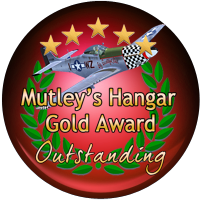 | |
| ● External Model: | 10/10 | |
| ● Internal Model: | 10/10 | |
| ● Sounds: | 9.0/10 | |
| ● Flight Characteristics (does it fly by the numbers): | 10/10 | |
| ● Flight Dynamics (does it feel like what it looks like): | 10/10 | |
| ● Documentation: | 9.0/10 | |
| ● Value for Money: | 10/10 |
The Aerosoft English Electric 'Lightning' F.3 is awarded an overall Mutley’s Hangar score of 9.7/10, with an "Outstanding" and a Mutley's Hangar Gold Award. |